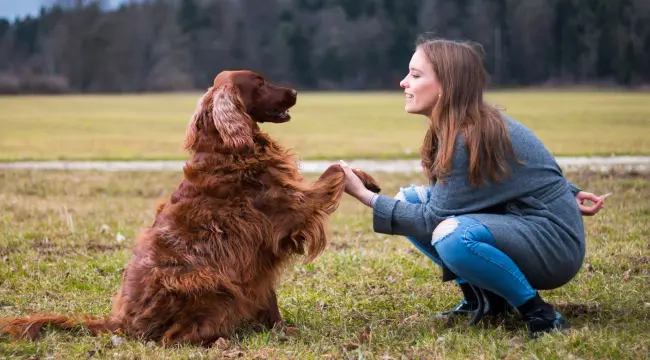
If you want to professionally train your dog to make it efficient and have a perfect stomach, we introduce you to the best method techniques. You can best prepare your dog by keeping the following procedures in mind. This article highlights some professional strategies to help your dog better understand sit, stay, poop, and bathroom training. A loyal dog is what every household wants to protect its possessions better.
A loyal dog’s loyalty is only proven when trained professionally with the best techniques. Dog training can be made much easier and more effective with these techniques. Beware while getting online training; always check their trust and reviews.
Positive Reinforcement
Veterinary professionals nearly universally concur that the best approach to dog training is positive reinforcement. Training that emphasizes positive reinforcement basically focuses on praising your pet for appropriate behavior instead of correcting inappropriate conduct.
Reward your canine companions if they behave well and obey your directions! You can strengthen the correlation between positive behavior and positive outcomes by providing rewards for excellent conduct.
Another crucial aspect to consider is whether you could unintentionally encourage undesirable conduct. Never acknowledge or give in to your dog’s negative behavior, such as jumping up to greet you or barking at you to play, as this will encourage it. As opposed to that, give them attention just once they’ve calmed.
Obedience Technique for Dog
Because of their intelligence, dogs can pick up the behaviors you desire. In addition, they possess the intelligence to understand what they can get away with.
Giving food, praise, or affection to a dog is one of the best ways to teach them a particular habit and train it. What matters most is that the prize they desire is the ideal one to provide them. Treats work better than praise if they are food-motivated. Love could be the best reward if they are begging for your attention.
Predictably rewarding your dog for desired behavior is the most important thing to concentrate on. Never encourage conduct that you find undesirable. The behavior should be awarded to your dog when it is executed. Their confusion arises when you ask them to lie down and then wait to reward them with a treat until they get back up. It will remain a mystery to them what action prompted the prize.
Encourage Technique for the Dog.
Encouraging a dog to come to you while playing is very effective. To use this Technique, you place a small toy in front of the dog, and he begins to play with it on foot. This can be a fun incentive for the dog and very beneficial. In this way, motivational elements occur in the dog’s temperament. As he will be inspired by play and fun through the reinforcement given by his owner, he will develop a positive attitude toward his owner. Encouraging positive factors in a dog can lead to positive motivation.
Home Training Technique for Dog
After taking your dog outdoors to relieve themselves, give them some freedom inside to explore and set them up for success. It can also be helpful to use a crate for this. When working on crate training, you can give your dog a high-value chew toy while in their box. Since dogs usually won’t eliminate where they sleep, they’ll go outdoors as soon as they get out to relieve themselves. Take them outside every hour, encouraging them to use the restroom more regularly; adult dogs can hold it for several hours on average. A chance to go out every couple of hours is necessary for puppies.
Waiting for Technique for Dog
The ” waiting technique” is helpful to learn for various situations, such as wanting your dog to wait at doors, entering or exiting a vehicle, and receiving food from you. Don’t be harsh, but don’t be soft, either. So long as the dog pauses when you deliver the cue, it doesn’t matter if it is sitting, standing, or lying down.
Stay Technique for the Dog
By keeping a dog away from potentially dangerous situations, teaching them the “Stay technique” can also be highly beneficial for their safety. The dog should be in a sit or down posture to begin learning to remain. Standing for an extended period can be physically demanding and may cause the dog to change positions to feel more comfortable.
Playing Technique for Dogs
We can increase the motivation for good behavior by playing different games with dogs. Retrieval is an excellent method to teach a dog through play. Always start with two toys to teach this Technique so that the dog runs to get one toy from you and tries to stuff it in his mouth. Commonly used words are out and drop. In addition, the game of tug teaches the dog rules and is a great way to feed a healthy educational game. In this game, the dog may accidentally grab your hand instead of the toy, but be safe by neutralizing it with a gentle uh-uh. Along with these games, teach the dog to find a toy by hiding it and encouraging him to find it so he can see it and bring it to you.
Social Technique for Dogs
Taking quality time out of your busy schedule with your pet dog is a great way to encourage good behavior. Teach your dog the Technique of enjoying your touch to sharpen his touch habit. This will make the dog feel comfortable touching other people when they touch them. It is essential to be kind and gentle to handle the dog and develop the best skills in it. Because these things associate contact with positive experiences within the dog, it is also essential to increase the dog’s lifting abilities.
Sometimes, the dog may need to be lifted off the ground for grooming, medical, or other reasons. For this exercise, you can raise the dog off the floor so that the dog does not feel unreasonable when picked up. Repeating this exercise repeatedly creates a positive departure within the dog. Sometimes, when walking in the community, the dog can meet people and other animals, so he is ready to gain awareness of social skills. This awareness can only be brought to him when he is taught the Technique of a solid connection with the people and animals living in society.
Well Behavior Technique for Dogs
When dogs are on their way to adulthood, they develop different habits, including jumping, playing with toys, greeting, etc. Do not encourage unwanted behavior in dogs. Instead, try to understand them positively and lovingly so that he learns the bad habit and avoids repeating the same mistake in the future.
A fantastic technique to help them stop biting or nipping is to act as though you are in agony when they do so rather than reprimanding them. It should work to say “OUCH” aloud; most puppies will quickly quit this activity since they are startled by the loud noise. Try substituting a toy for your hand if making loud noises does not deter them from nibbling at you. If you catch them biting and grab a toy or bone, you can stop them from continuing.
10 Most Well-Behaved Dog Breeds
Here is a list of 10 well-behaved dog breeds:
- Labrador Retriever: Known for their friendly and obedient nature, Labrador Retriever are one of the most well-behaved dog breeds. They are highly trainable and make excellent family pets.
- Golden Retriever: Golden Retrievers are gentle, intelligent, and obedient. They are great with children and adapt well to various living situations.
- Border Collie: Border Collies are incredibly smart and eager to please. They excel in obedience training and are often used in dog sports and agility.
- Poodle: Poodles come in standard, miniature, and toy sizes, but all are known for their intelligence and easy trainability. They are also hypoallergenic.
- German Shepherd: German Shepherds are loyal and protective, making them excellent working dogs and family pets. They are quick learners and highly obedient.
- Boxer: Boxers are known for their friendly and playful nature. They are relatively easy to train and are excellent companions.
- Shetland Sheepdog: These small herding dogs are intelligent and obedient. They are great for families and excel in agility training.
- Bichon Frise: Bichon Frises are cheerful and easy to train. They have a friendly disposition and make wonderful companions.
- Cavalier King Charles Spaniel: These dogs are known for their affectionate and well-behaved nature. They adapt well to various living situations and are easy to train.
- Doberman Pinscher: Dobermans are highly obedient and protective. They require proper training and socialization but make loyal and well-behaved pets when done so.
Remember that individual temperament can vary, so it’s essential to provide proper training, socialization, and care for any dog, regardless of its breed.
Final Thoughts
Most importantly, being patient and consistent is vital while training a puppy or an adult dog. Always give priority, keep the good health of your dog, and keep care to avoid any injury. If it happens, visit nearly emergency vet clinics quickly to get a bandage. It is never the goal of discipline to punish. It’s a sign that something is seriously wrong if you’ve reached a stage where you believe punishment is required. Establishing boundaries and standards that your dog can comprehend, together with developing a set of behaviors, are the actual goals of dog discipline.



